Genre: Maze Game Developer: Sega of Japan Publisher: Sega of Japan Players: 1-4 Released: 1995
Single-screen maze chase games were once a staple of the arcades, represented worldwide by the iconic Pac-Man and all his many family members. For a time, they were practically all you could find. Among the many offerings and overshadowed by Nacmo’s massive series of hits was a little gem by Coreland and Sega called Pengo. Featuring a cute little penguin who kicked ice at oncoming baddies, the game was simple to learn, but in the same vein as Hudson’s long-lived Bomberman, it was hard as nails to master. As technology progressed and the industry proved itself to be more than a passing fad, new and more complex genres emerged, leaving the single-screener and Pengo to take their rightful places in history.
Fast forward a decade, and after a only allowing him a few brief cameos here and there, Sega finally decides to bring ol’ Pengo back for another run on its Game Gear portable. This was the first time American gamers would get to play as the elusive penguin at home since the original game had been ported to the early Atari consoles and computers, and what they got was basically another straight-up port. It wasn’t until three years later that Sega would go all-out and totally remake the game for the Mega Drive. And like every other brain dead decision by the company in 1995, it left the game in Japan.
It makes you want to pull your hair out, literally. Along with other incredible titles like Monster World IV and Pulseman, Sega left an amazing new version of an excellent arcade game in its home country, forcing westerners to pay through the nose and wait for that darn UPS truck to finally find their houses. The decision makes no sense, as the game is almost completely in English anyway, and porting it would have taken a minimal effort. I guess it was more important to kill of the 32X and totally fumble the Saturn’s launch. Priorities, people, priorities…
Sega’s unfortunate decision not to bring Papenga Pengo (henceforth referred to simply as Pengo) deprived gamers of a great maze chase experience that was playable with up to four people (in Battle mode). The single-player game remains essentially the same as the arcade original: kick blocks of ice at oncoming enemies until you clear the screen. This time, however, Sega has upped the ante by including different goodies, like arrows that change the direction of the ice, allowing you to hit several foes in different areas at once. It can be really cool to take out a few walruses or triceratops with one block and still have time to grab that ice cream bonus!
Pengo’s ten worlds are divided into multiple stages – two or three regular stages and a boss battle, and gameplay appears to be as simple as the world structure itself. You only use two buttons, one for Pengo’s new-found ability to create blocks of ice (he pushed existing blocks in the arcade original and couldn’t create them) and one to kick them. Eliminating obstacles on the field can nab you bonuses like ice cream, a dollar sign for big points, and the all-important clock, which freezes enemies for a few seconds and gives you valuable time to set up your offense. As I mentioned earlier, those who have played any Bomberman game will instantly feel right at home.
And just as with Hudson’s game, the difficulty ramps up quite quickly. Some of the enemies, which change depending on the level in play, have the ability to smash through your ice blocks, while others explode and can take you with them when they die if you’re too close. Even the stages themselves pose a challenge when they litter the landscape with pottery or other items and impede movement. Some stages even shoot at you! It takes some quick thinking to use the arrows to your advantage and get as many baddies with a single block as possible, which clears a path for you and saves times. That clock only gives you three minutes per level, so you have to work quickly to clean things up. Sega thankfully included a simple four-character password system, so you never have to start over from scratch.
The boss battles are both fun and engaging, and the game continues to challenge you here by including a reduced time limit. Some bosses initially seem impossible to beat in the meager two minutes you’re given until you find their pattern, but once their particular weaknesses have been discovered, you’ll be taking them out in no time flat. None are particularly hard, but the combination of evading their attacks while trying to find out the quickest way to beat them gives them just the right amount of challenge.
In addition to the single-player game, Pengo also features a Battle mode that lets up to four players battle it out Bomberman-style. By now, you’ve probably seen that there are quite a few similarities between the two games, and I don’t think that’s an accident. Everything about this game reminds me of Bomberman, and the graphics look eerily similar to the Genesis’ own Mega Bomberman. It wouldn’t surprise me if Pengo is running on the same engine. Even so, the Battle mode is great fun, and you can always use up to three bots if you’re lonely and have no one with whom to play.
An awesome addition to this release is the inclusion of the original arcade mode, which is complete except for the Popcorn tune that used to play. It was most likely removed for licensing reasons, but you won’t miss it all that much. The arcade version is much simpler in execution than the remake, but it’s just as hard, and you’ll soon remember why people poured so many quarters into those early ’80s arcade games. They were brutal!
At the end of the day, Pengo is a great addition to any true Genesis fan’s library, and it has everything you could ask for in a single-screen maze chase title: great visuals and audio and rock-solid gameplay. Truth be told, there are perhaps only two real reasons why you shouldn’t be seeking it out: availability and cost, and the two sadly go hand in hand. You’ll most likely only find a copy on eBay, and more often than not it’s going to cost you a pretty penny. Still, it’s well worth the cash if you can find it, and it provides some great fun when you don’t want to really spend too much time thinking about what you’re playing. The password feature means you can take your time with it and go slow through the story mode, and the Battle mode is there for when you want to punish your family or friends. The inclusion of the arcade original is just the icing on the cake. Do yourself a favor and hunt this one down.
SCORE: 9 out of 10


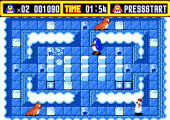
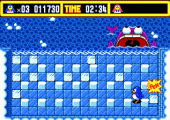
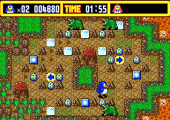
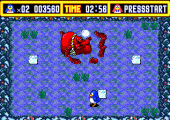
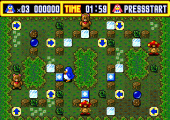
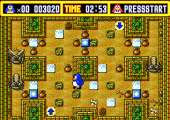
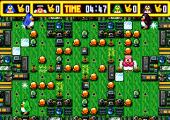
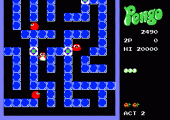
Recent Comments